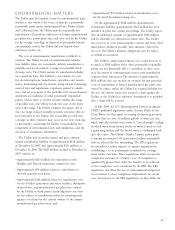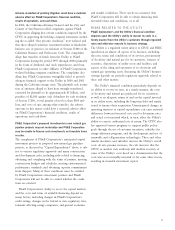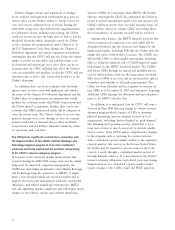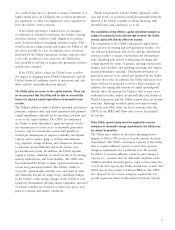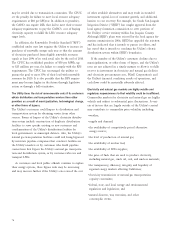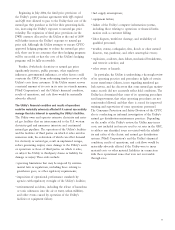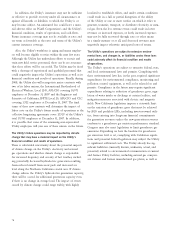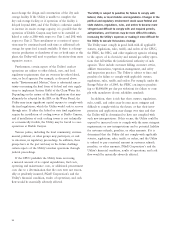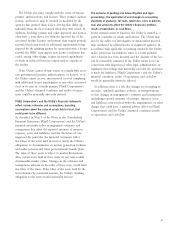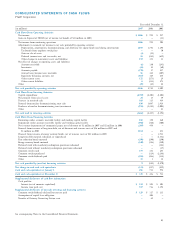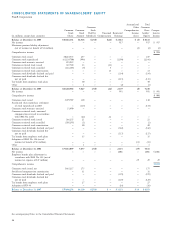PG&E 2007 Annual Report Download - page 78
Download and view the complete annual report
Please find page 78 of the 2007 PG&E annual report below. You can navigate through the pages in the report by either clicking on the pages listed below, or by using the keyword search tool below to find specific information within the annual report.76
may be needed due to transmission constraints. The CPUC
set the penalty for failure to meet local resource adequacy
requirements at $40 per kW-year. In addition to penalties,
the CAISO can require LSEs that fail to meet their resource
adequacy requirements to pay the CAISO’s cost of buying
electricity capacity to fulfi ll the LSEs’ resource adequacy
target levels.
In addition, the Renewables Portfolio Standard (“RPS”)
established under state law requires the Utility to increase its
purchases of renewable energy each year so that the amount
of electricity purchased from eligible renewable resources
equals at least 20% of its total retail sales by the end of 2010.
The CPUC has established penalties of $50 per MWh, up
to $25 million per year, for failure to comply with the RPS
requirements. The CPUC has encouraged the utilities to
pursue the goal to meet 33% of their load with renewable
resources by 2020. It is also possible that the RPS require-
ment may become higher in the future through legislative
action or through a ballot initiative.
The Utility faces the risk of unrecoverable costs if its customers
obtain distribution and transportation services from other
providers as a result of municipalization, technological change,
or other forms of bypass.
The Utility’s customers could bypass its distribution and
transportation system by obtaining service from other
sources. Forms of bypass of the Utility’s electricity distribu-
tion system include construction of duplicate distribution
facilities to serve specifi c existing or new customers and
condemnation of the Utility’s distribution facilities by
local governments or municipal districts. Also, the Utility’s
natural gas transportation facilities could risk being bypassed
by interstate pipeline companies that construct facilities in
the Utility’s markets or by customers who build pipeline
connections that bypass the Utility’s natural gas transporta-
tion and distribution system, or by customers who use and
transport LNG.
As customers and local public offi cials continue to explore
their energy options, these bypass risks may be increasing
and may increase further if the Utility’s rates exceed the cost
of other available alternatives and may result in stranded
investment capital, loss of customer growth, and additional
barriers to cost recovery. For example, the South San Joaquin
Irrigation District (“SSJID”) has sought approval from the
local agency formation commission to serve portions of
the Utility’s service territory within San Joaquin County.
Although SSJID’s plans were rejected by the local agency for-
mation commission in 2006, SSJID has appealed the rejection
and has indicated that it intends to pursue its efforts, and
has stated that it intends to condemn the Utility’s electric
distribution system within SSJID’s boundaries.
If the number of the Utility’s customers declines due to
municipalization, or other forms of bypass, and the Utility’s
rates are not adjusted in a timely manner to allow it to fully
recover its investment in electricity and natural gas facilities
and electricity procurement costs, PG&E Corporation’s and
the Utility’s fi nancial condition, results of operations, and
cash fl ows could be materially adversely affected.
Electricity and natural gas markets are highly volatile and
regulatory responsiveness to that volatility could be insuffi cient.
Commodity markets for electricity and natural gas are highly
volatile and subject to substantial price fl uctuations. A vari-
ety of factors that are largely outside of the Utility’s control
may contribute to commodity price volatility, including:
• weather;
• supply and demand;
• the availability of competitively priced alternative
energy sources;
• the level of production of natural gas;
• the availability of nuclear fuel;
• the availability of LNG supplies;
• the price of fuels that are used to produce electricity,
including natural gas, crude oil, coal, and nuclear materials;
• the transparency, effi ciency, integrity, and liquidity of
regional energy markets affecting California;
• electricity transmission or natural gas transportation
capacity constraints;
• federal, state, and local energy and environmental
regulation and legislation; and
• natural disasters, war, terrorism, and other
catastrophic events.





